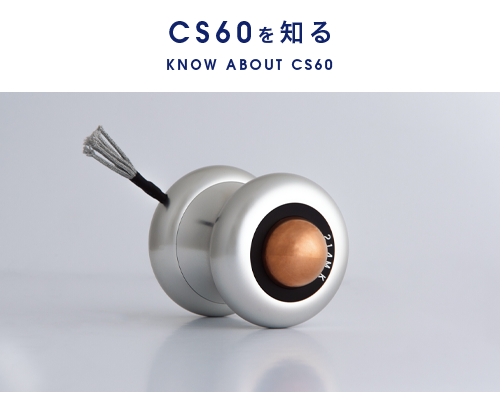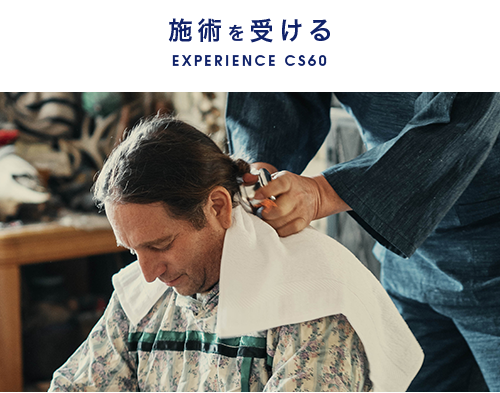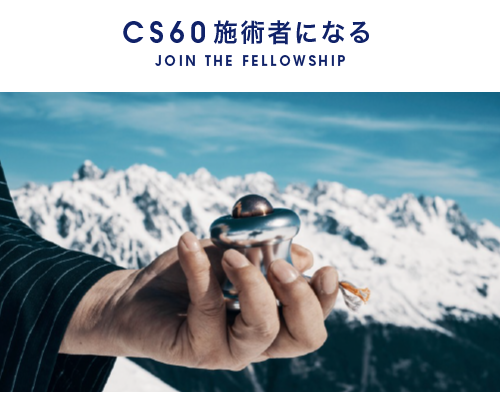
- 2019/12/19
-
Newsletter Vol.37
カメラマン・中村祥一さんインタビュー(前編)
Interview with Cameraman Shoichi Nakamura (Part I)
Interview avec un photographe nommé Shoichi Nakamura (Première partie)  今回はCS60の写真撮影や映像制作を担当する、カメラマンの中村祥一さんにインタビューしました。
今回はCS60の写真撮影や映像制作を担当する、カメラマンの中村祥一さんにインタビューしました。
――――――――――――
―中村さんがCS60と出会ったのはいつごろですか?中村:2018年の6月29日です。僕の人生にとってかなり重要な日なので、Google Calendarで日程も記録しています(笑)。
20歳くらいのときから、10年に1回ぐらい脊椎すべり症で動けなくなって、救急車入院していました。「腰が痛いなら試してみたら?」と知り合いに紹介され、新井薬師に行ったのが最初です。そのご縁で、今は西村先生の活動に同行し、写真や映像を撮らせていただいています。―中村さんもご自身のCS60をお持ちですよね?
中村:はい。映像にするにあたって、CS60のとらえ方や、伝え方を自分なりに研究してみようと思ったのです。知り合いや仕事場などであらゆる肩書の人に試しました。説明を聞いてすぐに受け入れる人もいれば、半信半疑の人もいます。相手によってどんな反応が出るのかも含めて、観察しました。最初は手応えがありませんでしたが、あるタイミングで急に効果が感じられるようになったのです。自転車を練習するときって、乗れないときは乗れるイメージが全く想像できませんが、あるとき急に乗れるようになりますよね。それと同じ感覚でした。
―いろいろな方を施術して感じたことを教えてください。
中村:CS60はコミュニケーションにすごく役に立つツールだと思います。痛みという、ふつうは表に出さない記憶と紐付いたプライベートな部分にいきなりアプローチできるので、一気に距離が縮まる可能性を感じています。
―WEB用の動画をつくるときには、どんなことを意識していたのですか?
中村:CS60をどんなふうに伝えるべきか考えて、いろいろな映画を研究しました。その中で一番参考になったのは『エクソシスト』です。エクソシスト関連のドキュメンタリーを見たり、本を読んだりするにつれて、CS60と共通点があると気づきました。
―エクソシストは、悪霊払いですよね。どういうところが共通しているのですか?
中村:エクソシストは、苦しんでいる人の中から何かを取り出そうとします。映画では、悪霊にとりつかれた女の子が空中に浮いたり、えびぞりになって逆さまに歩いたりしていました。あれは極端な表現ですが、悪霊払いの過程で苦しんだり、過去と向き合ったりして、人格がどんどん変わっていくのです。
―たしかに苦しんでいる人に触れ、中にあるものを取り出すことで、問題が改善するという点ではCS60と似ていますね。
中村:そうなんです。動画にもこんなコピーを入れました。「痛みを取り除くことはあなたが苦しんでいた記憶からあなたを解放することである」「記憶が部分的に更新された時、意識の発生プロセスが再起動されあなたの決断が変わります」「それはバタフライ効果となり、あなたの人生が変わります」
―どういう意味ですか?
中村:人は何かを決断するとき、無意識に脳のメモリーの記憶にアクセスしています。つまり過去の経験を、自分の決断材料にしているのです。記憶の中には、病気や怪我の経験も入っています。CS60で痛みの記憶を取り除くことによって、その人の決断が変わり、未来を変えられるのではないかというのが僕の仮説です。ただし、取ってはいけない痛みもあるだろうなという気がしています。
(つづく)
This time we will be interviewing cameraman Shoichi Nakamura, who handles photography and audiovisual production for CS60.
――――――――――――– When did you first encounter the CS60?
Nakamura: It was June 29, 2018.
This was a very important day in my life. I even have it marked in Google Calendar! Since I was about 20, once every 10 years or so I have had spondylolisthesis, and have had to be rushed to the hospital. A friend of mine introduced me to it, saying I should try it since I had lower back troubles. The first time I went was to the Araiyakushi location. Thanks to that, I now follow Dr. Nishimura, doing photography and videography.– Do you also have a CS60 of your own?
Nakamura: Yes. In filming for the CS60, I decided to learn about how to handle and promote the CS60 for myself. I have tried it on all kinds of people, whether among my acquaintances or at work. Some of them accept it straight away, and some of them are skeptical. I make observations of everything, including how the person I’m talking to reacts.
At first, I couldn’t feel a response from the device. Then at some point I could suddenly feel its effects. Take learning to ride a bike. When you still can’t ride, it’s impossible to imagine what riding a bike is like, then at some point you just suddenly can. It’s like that.– Tell us about what you have felt in treating various people.
Nakamura: I think the CS60 is a really important tool for communication. I feel that the CS60 lets you approach people in private place, where they store memories they don’t normally allow on the surface, namely their pain. This allows it to all of a sudden close the distance between people.
– What sorts of things do you pay attention to when you are making videos for the web?
Nakamura: I studied a variety of films to figure out how best to convey what the CS60 is. The one that I found most useful for that was The Exorcist. In reading books and watching documentaries about The Exorcist, I picked up on more and more similarities between it and the CS60.
– The Exorcist is about the banishing of evil spirits, right? What does it have in common with the CS60?
Nakamura: An exorcist attempts to take something out of a person who is suffering. In the movie, the girl who has the exorcism performed on her floats in mid-air, and walks backwards with her body contorted. It’s an extreme way to express it, of course, but as she goes through the exorcism process and faces her past, her character gradually changes.
– I suppose it does resemble the CS60 in the sense that it involves touching a suffering person, taking out what it is that is inside of them, and improving their problem.
Nakamura: That’s right. I even put copy in the videos, like: “Removing your pain will free you from your painful memories,” or “when you partially update your memories, you reset the process that gives rise to your consciousness, and fill yourself with new determination,” or “this will start the butterfly effect that changes your whole life.”
– What does that mean?
Nakamura: When people make decisions about things, they are subconsciously accessing the memories stored in their brains. In other words, your past experiences are the raw materials for your decisions today. But your memories also contain your experiences of sickness or injury.
In my hypothesis, the CS60, by removing painful memories, changes the will of the person being treated, and so changes their whole future. That said, I also have the feeling that there are pains that should not be removed.(To be continued…)
Nous avons interviewé le photographe Shoichi Nakamura qui est chargé des photographies et du montage des vidéos du CS60.
――――――――――――– Quand est-ce que vous avez rencontré le CS60 ?
Nakamura : Je l’ai rencontré le 29 juin 2018.
C’est une date très importante pour ma vie alors je l’ai notée dans mon Google Agenda (lol).
Depuis que j’ai 20 ans à peu près, tous les dix ans j’ai des crises de spondylolisthésis jusqu’à ne plus pouvoir bouger. On me transporte en ambulance et je suis hospitalisé.
Comme j’ai mal au dos, une connaissance m’a présenté le CS60 et je suis allé à Araiyakushi pour la première fois.
J’y ai rencontré le Professeur Nishimura et je l’accompagne maintenant pour prendre des photos et faire des vidéos.– Vous avez vous-même aussi le CS60, n’est-ce pas ?
Nakamura : Oui. Pour faire des vidéos concernant le CS60, j’ai voulu comprendre le CS60 afin de réfléchir à comment le faire comprendre. J’ai essayé le CS60 avec des amis et des collègues. Il y avait des gens qui l’acceptaient tout de suite mais il y avait aussi des gens qui doutaient même après mes explications. J’ai également observé des résultats qui diffèrent selon des patients.
Je ne voyais pas les effets du CS60 au début mais j’ai soudainement pu les ressentir.
C’était comme faire du vélo : quand vous ne savez pas en faire, vous ne pouvez même pas imaginer comment en faire. Pourtant, vous arrivez tout à coup à manier le vélo.– Pouvez-vous nous raconter ce que vous avez ressenti après avoir soigné différents types de gens ?
Nakamura : Le CS60 est un outil qui sert à la communication.
Grâce au CS60, je peux directement toucher aux maux des patients : les maux sont des « parties privées » qui sont normalement cachées et liées à la mémoire. Je ressens que le CS60 me permet de raccourcir rapidement les distances avec mes patients.– À quoi faites-vous attention lorsque vous faites des vidéos pour le site Internet du CS60 ?
Nakamura : J’ai observé différents types de film en réfléchissant à comment faire connaître le CS60. Le film qui m’a inspiré le plus était « L’Exorciste ».
En regardant des documentaires et en lisant des livres concernant ce film, je me suis rendu compte qu’il avait un point commun avec le CS60.– « L’Exorciste » est un film dont l’histoire parle d’exorcisme.
Pourrez-vous expliquer le point commun que vous avez trouvé ?Nakamura : L’exorciste essaie d’éliminer des choses dans les gens qui souffrent.
Dans le film, il y a une fille possédée qui flotte dans l’air et qui marche à l’envers en se cambrant.
C’est vrai que c’est une expression extrême. Les personnalités changent après les souffrances de l’exorcisme et après avoir regardé le passé.– C’est vrai que le film a un point commun avec le CS60 : on touche les gens qui souffrent et on fait sortir des choses pour régler des problèmes.
Nakamura : Oui. J’ai intégré dans les vidéos des phrases comme celles ci-dessous :
« Éliminer des douleurs, c’est vous libérer des mémoires qui vous font souffrir »
« Lorsque vos mémoires sont partiellement mises à jour, le processus de conscience est redémarré et vos choix changent »
« Cela fait effet papillon. Votre vie change »– Qu’est-ce que cela veut dire ?
Nakamura : Lorsque vous décidez quelque chose, vous accédez inconsciemment à votre mémoire dans le cerveau.
Cela veut dire que vous utilisez vos expériences pour prendre une décision.
Il existe également des expériences liées à la maladie et aux blessures dans votre mémoire.
Je suppose que vos décisions changent grâce à l’élimination des douleurs et que votre futur change.
Je pense pourtant qu’il y a des douleurs qu’il ne faut pas éliminer.(À suivre)
INDEX
















